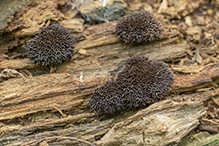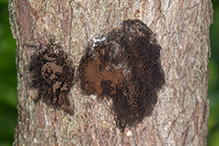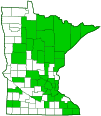chocolate tube slime
(Stemonitis splendens)
Conservation • Description • Habitat • Ecology • Distribution • Taxonomy
|
|
||||||||||||||
Description |
Stemonitis splendens is a common, cosmopolitan, slime mold. Its common name is chocolate tube slime, which is also the common name of the genus Stemonitis. It occurs on every continent except Antarctica. In the United States, it occurs east of the Great Plains and on the West Coast, with very few scattered records between. It is common in Minnesota. Chocolate tube slime is found in sheltered areas on decaying wood and fallen leaves. It does not feed on the wood but on bacteria, fungal spores, plant spores, protozoa, and particles of non-living organic matter. The fruiting body is a mushroom-like structure for producing spores (sporangium). The sporangium has three growth stages. The first stage is the formation of the spore-bearing head (sporotheca). The sporotheca is a cell with a single nucleus and without an outer wall. When it first appears, the sporotheca is a small, milky-white sphere. At this stage, a cluster of these spheres looks like a mass of snail eggs. It gradually elongates, becoming cylindrical and 1⁄32″ to 5⁄64″ (0.8 to 2.1 mm) long. The second stage is stalk formation. When the sporotheca reaches its full height, the constricted base continues to elongate, forming a slender, 3⁄32″ to 5⁄32″ (2.3 to 3.8 mm) long stalk. The third and final stage is sporangium maturity. The color of the sporotheca changes from milky white to pinkish, then to pink, then to reddish brown, then ultimately to dark brown as the spores mature. The mature sporangium is ⅜″ to ¾″ (10 to 20 mm) tall and 1⁄32″ to 1⁄16″ (1 to 2 mm) in diameter. The stalk is shiny black and ⅛″ to 3⁄16″ (3 to 5 mm) long. The sporangia appear in dense clusters, often forming large tufts. The entire development, growth, and maturation of the sporangium takes less than one day. |
Similar Species |
Habitat and Hosts |
Decaying wood and fallen leaves |
Ecology |
Season |
|
Distribution |
||
|
Sources Biodiversity occurrence data published by: Minnesota Biodiversity Atlas (accessed through the Minnesota Biodiversity Atlas Portal, bellatlas.umn.edu, 11/21/2024). |
|
| 11/21/2024 | ||
Occurrence |
||
Common |
||
Taxonomy |
|
Kingdom |
Protozoa (protozoans) |
Phylum |
Mycetozoa (slime molds) |
Class |
Myxomycetes (true slime molds) |
Subclass |
Columellomycetidae |
Superorder |
Stemonitidia |
Order |
Stemonitidales |
Family |
Stemonitidaceae |
Genus |
Stemonitis (chocolate tube slimes) |
|
|
Higher ranking |
|
Subordinate Taxa |
|
|
|
Synonyms |
|
Stemonitis acuminata Stemonitis baeuerlinii Stemonitis fenestrata Stemonitis lignicola Stemonitis morganii Stemonitis webberi |
|
Common Names |
|
chocolate tube slime chocolate tube slime mold tree hair |
|
Glossary
Sporangium
A spore bearing structure, as of a fern, moss, or slime mold. Plural: sporangia.
Visitor Photos |
||
Share your photo of this slime mold. |
||
This button not working for you? |
||
Greg Watson |
||
 |
||
Chocolate Slime Mold I’m fairly certain that the attached pictures show Chocolate Slime Mold, Stemontis splendens, on an American Red Bud branch. I barely touched it, and a cloud of spores were released. The Red Bud is in my backyard in La Crescent. |
||
 |
 |
|
MinnesotaSeasons.com Photos |
||
|

Slideshows |
|

Visitor Videos |
||
Share your video of this slime mold. |
||
This button not working for you? |
||
|
Other Videos |
||
Beautiful Stemonitis splendens |
About
Jun 22, 2024 Slime molds |
Stemonitis splendens |
About
Jan 5, 2016 Stemonitis splendens |

Visitor Sightings |
||
Report a sighting of this slime mold. |
||
This button not working for you? |
||
| Greg Watson 6/22/2025 |
Location: Magelssen Bluff Park |
 |
MinnesotaSeasons.com Sightings |
||
|

|
Created: 11/21/2024 Last Updated: © MinnesotaSeasons.com. All rights reserved. |

